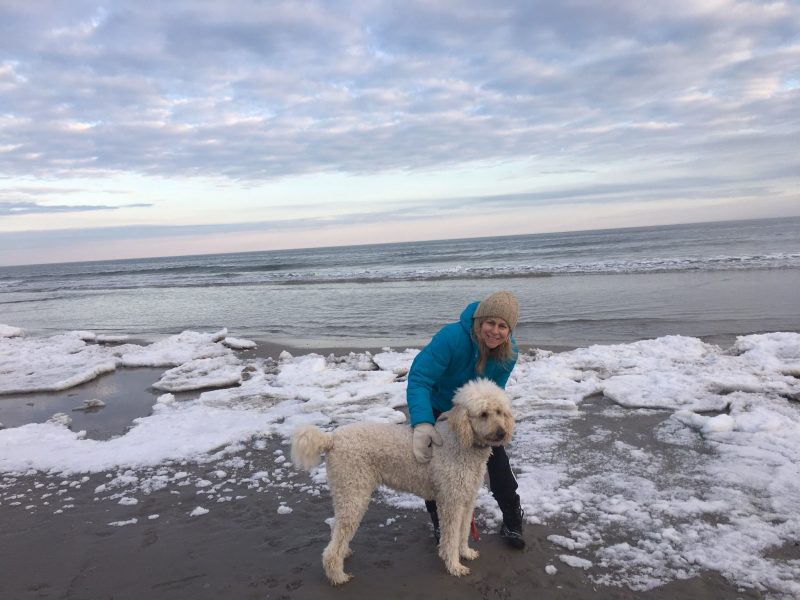Ocean City resident Jill Nuss and her dog Sunny had an interesting walk on the beach Friday, when they came upon a seal taking a rest.
 By Maddy Vitale
When Jill Nuss took her dog Sunny for an early morning walk on the beach in Ocean City Friday, it was like any other stroll. The standard poodle romped in the sands and explored the water’s edge.
And then it happened. While heading to the 24th Street beach, Sunny pulled on the leash and barked continuously. Quickly, what was routine turned into something quite different.
“She was dragging me. There was so much fog, I couldn’t see much, and then all of a sudden, I saw a seal lying on the beach,” Nuss, of Ocean City, said. “I thought it was hurt.”
Sunny barked at the seal, but didn’t get real close, Nuss said.
Immediately, Nuss called the Humane Society of Ocean City to report the sighting. She also called her husband Brad Nuss. But minutes later, the seal went back into the ocean and did not appear hurt. She called the HSOC with the updated information.
“They said someone may come out still,” Nuss said. “I guess they would have to go looking in the waters.”
For Nuss, who loves giving her active dog lots of walks, it was exciting.
“It was so cool to see a seal close up. He had dark, sweet eyes with these big whiskers and he was light brown,” Nuss said. “There was so much fog and it was cold and wet, but just seeing him was worth it.”
By Maddy Vitale
When Jill Nuss took her dog Sunny for an early morning walk on the beach in Ocean City Friday, it was like any other stroll. The standard poodle romped in the sands and explored the water’s edge.
And then it happened. While heading to the 24th Street beach, Sunny pulled on the leash and barked continuously. Quickly, what was routine turned into something quite different.
“She was dragging me. There was so much fog, I couldn’t see much, and then all of a sudden, I saw a seal lying on the beach,” Nuss, of Ocean City, said. “I thought it was hurt.”
Sunny barked at the seal, but didn’t get real close, Nuss said.
Immediately, Nuss called the Humane Society of Ocean City to report the sighting. She also called her husband Brad Nuss. But minutes later, the seal went back into the ocean and did not appear hurt. She called the HSOC with the updated information.
“They said someone may come out still,” Nuss said. “I guess they would have to go looking in the waters.”
For Nuss, who loves giving her active dog lots of walks, it was exciting.
“It was so cool to see a seal close up. He had dark, sweet eyes with these big whiskers and he was light brown,” Nuss said. “There was so much fog and it was cold and wet, but just seeing him was worth it.”
 Jill Nuss and her dog Sunny had an interesting walk on the beach Friday.
Marine Mammal Stranding Center Director Bob Schoelkopf said after looking at the photo by Nuss, that it was a yearling harbor seal.
“This species comes to New Jersey beaches every winter about this time. The animal came ashore probably after feeding to get some sleep,” Schoelkopf explained.
Jill Nuss and her dog Sunny had an interesting walk on the beach Friday.
Marine Mammal Stranding Center Director Bob Schoelkopf said after looking at the photo by Nuss, that it was a yearling harbor seal.
“This species comes to New Jersey beaches every winter about this time. The animal came ashore probably after feeding to get some sleep,” Schoelkopf explained.  After some rest at the 24th Street beach, this young harbor seal took to the waters.
After some rest at the 24th Street beach, this young harbor seal took to the waters.